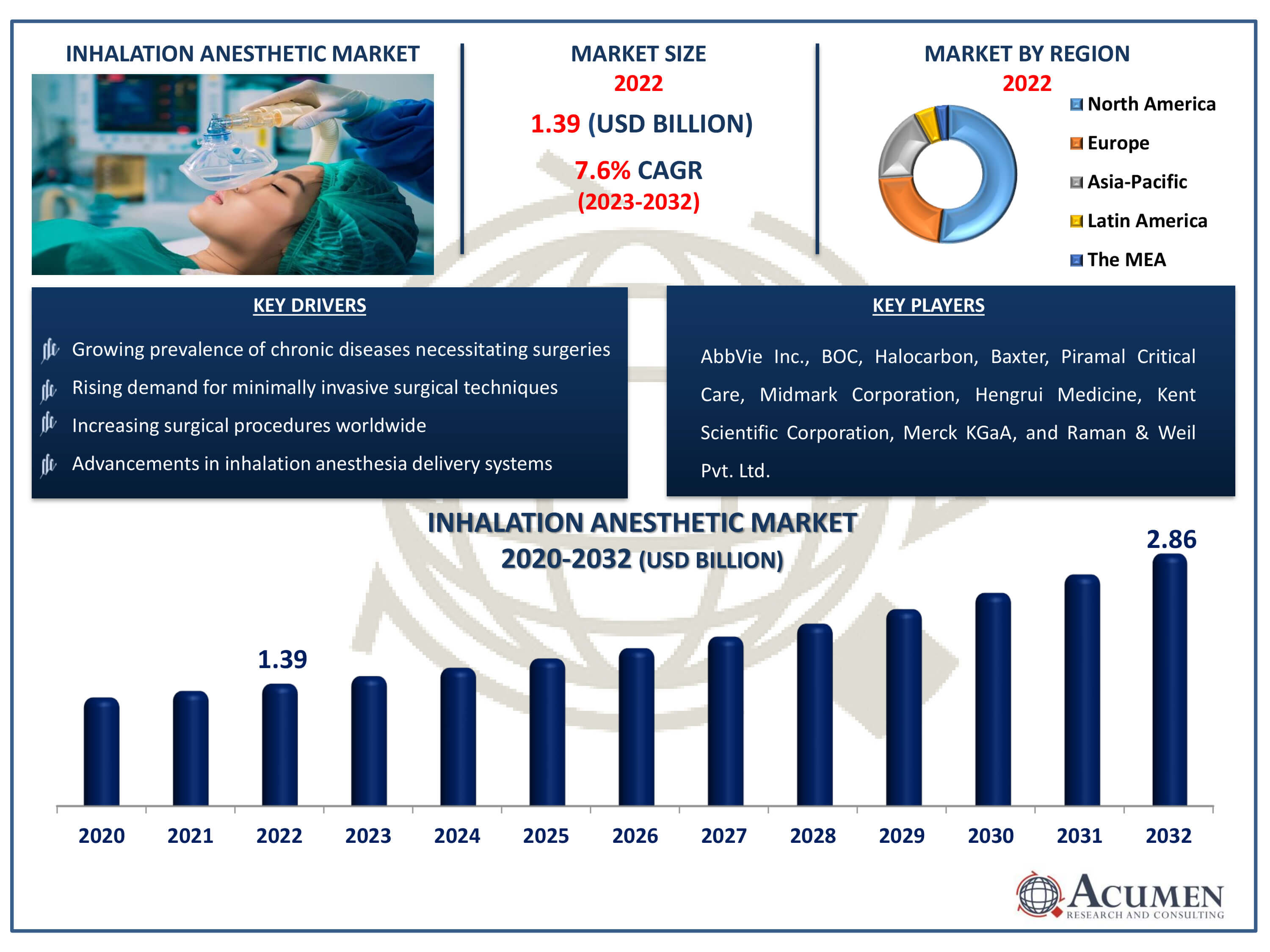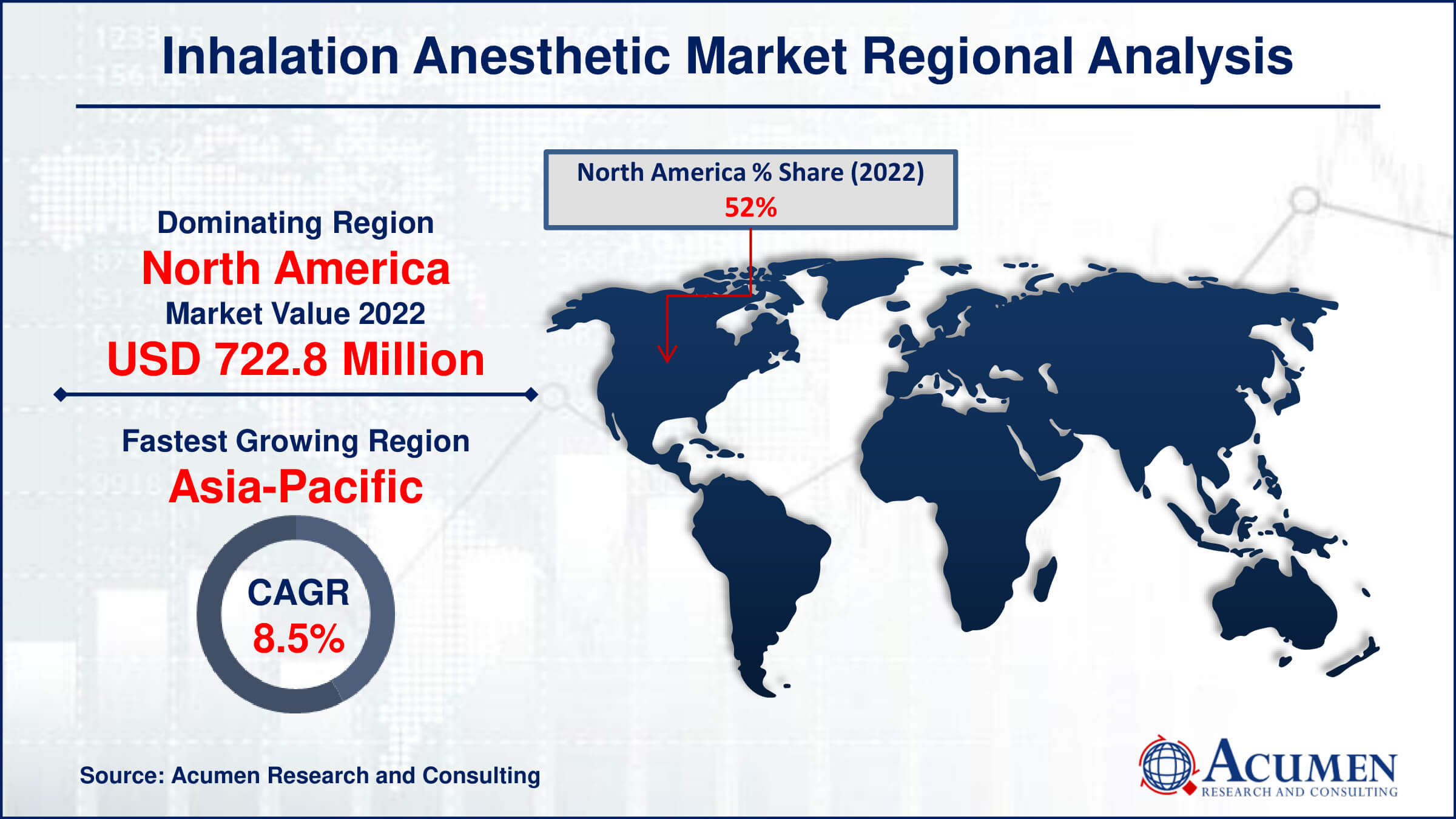August 2023
Inhalation Anesthetic Market Size accounted for USD 1.39 Billion in 2022 and is estimated to achieve a market size of USD 2.86 Billion by 2032 growing at a CAGR of 7.6% from 2023 to 2032.
The Inhalation Anesthetic Market Size accounted for USD 1.39 Billion in 2022 and is estimated to achieve a market size of USD 2.86 Billion by 2032 growing at a CAGR of 7.6% from 2023 to 2032.
Inhalation Anesthetic Market Highlights

Anesthesia is a medically induced condition of insensitivity to sensations caused by the use of anesthetics. These drugs affect the central nervous system by modifying neuron function and suppressing pain perception. Anesthesia is used in a variety of surgical operations, making the process easier for both healthcare personnel and patients. Anesthetic drugs can be provided via a variety of ways, including subcutaneous injection, oral consumption, intravenous infusion, and inhalation. Inhalation anesthetics, in particular, are widely used to produce and maintain a state of general anesthesia during surgical procedures. These drugs are often administered by tracheal tubes or masks, ensuring appropriate diffusion throughout the respiratory system and effective anesthesia. The anesthetic agent and delivery mechanism are chosen based on the patient's particular needs and the requirements of the surgical treatment, with the primary goal of administering anesthesia safely and comfortably to optimize patient outcomes.
Global Inhalation Anesthetic Market Dynamics
Market Drivers
Market Restraints
Market Opportunities
Inhalation Anesthetic Market Report Coverage
| Market | Inhalation Anesthetic Market |
| Inhalation Anesthetic Market Size 2022 | USD 1.39 Billion |
| Inhalation Anesthetic Market Forecast 2032 |
USD 2.86 Billion |
| Inhalation Anesthetic Market CAGR During 2023 - 2032 | 7.6% |
| Inhalation Anesthetic Market Analysis Period | 2020 - 2032 |
| Inhalation Anesthetic Market Base Year |
2022 |
| Inhalation Anesthetic Market Forecast Data | 2023 - 2032 |
| Segments Covered | By Product, By Application, By End-Use, And By Geography |
| Regional Scope | North America, Europe, Asia Pacific, Latin America, and Middle East & Africa |
| Key Companies Profiled | AbbVie Inc., BOC, Halocarbon, Baxter, Piramal Critical Care, Midmark Corporation, Hengrui Medicine, Kent Scientific Corporation, Merck KGaA, and Raman & Weil Pvt. Ltd. |
| Report Coverage |
Market Trends, Drivers, Restraints, Competitive Analysis, Player Profiling, Covid-19 Analysis, Regulation Analysis |
Inhalation Anesthetic Market Insights
The growing elderly population, which suffers from a variety of chronic conditions such as cardiovascular, cancer, neurological, respiratory, orthopaedic, and spinal disorders, is a major driver of the inhalation anesthesia market. As the older population expands, so will the demand for surgical procedures to treat chronic illnesses. Inhalation anaesthetics serve an important role in providing safe and effective anesthesia during surgical operations for this population. The possible adverse effects of inhalation anesthetics, such as slow or fast heart rate, increased salivation, and breath holding, may impede market expansion. These unfavourable responses may lead to cautious adoption by healthcare practitioners and patients, limiting market development.
On the other hand, the growing number of accidents and emergency cases, as well as the increased prevalence of cataracts, are propelling the ambulatory surgery industry forward. Because of their rapid onset and recovery features, inhalation anesthetics are frequently used in ambulatory or outpatient procedures, creating attractive potential for market expansion. These treatments, which are conducted outside of standard hospital settings, need efficient and dependable anesthesia to assure patient safety and comfort. Furthermore, technical improvements in inhalation anesthesia administration systems help to drive market expansion by improving safety, accuracy, and patient outcomes. Closed-circuit anesthesia systems and vaporizers are examples of innovations that enable more precise anesthesia delivery and monitoring, lowering the risk of side effects and increasing the overall patient experience.
Moreover, the growing use of less invasive surgical methods, driven by patient preferences for faster recovery and shorter hospital stays, increases demand for inhalation anesthetics market. These techniques frequently need anesthesia for patient comfort throughout treatments, which fuels market development.
Inhalation Anesthetics Market Segmentation
The worldwide inhalation anesthetics market is split based on product, application end-use, and geography.
Inhalation Anesthetics Market By Products
According to inhalation anesthetic industry analysis, the sevoflurane segment dominates the market owing to its widespread usage in numerous surgical procedures. Sevoflurane is recommended by anesthesiologists and healthcare professionals because to its quick onset and offset. It also provides a seamless induction and recovery from anesthesia. Its modest pungency and little airway irritation improve patient comfort during inhalation. Furthermore, sevoflurane's favourable pharmacokinetic profile and limited metabolism make it suitable for usage in a wide range of patient demographics, including paediatric and elderly patients. With developments in anesthesia delivery technologies and increased use of outpatient procedures, demand for sevoflurane is likely to rise further, cementing its position as the leading product in the inhalation anesthetics market.
Inhalation Anesthetics Market By Applications
The maintenance segment is significant in the inhalation anesthesia market because of its critical function in maintaining anesthesia throughout surgical operations. Once the patient is put under anesthesia, the maintenance phase entails constantly giving inhalation anaesthetics to maintain the optimum amount of unconsciousness and analgesia. This phase guarantees that the patient remains immobile, comfortable, and pain-free during the surgical process. Healthcare personnel actively monitor and alter inhalation anaesthetic dosages to maintain anesthesia depth while minimizing side effects. With the growing occurrence of operations requiring prolonged anaesthesia durations, such as difficult surgeries or procedures with lengthy recovery times, the maintenance sector is seeing strong demand, resulting in its dominance in the inhalation anesthesia market.
Inhalation Anesthetics Market By End-Uses
The hospitals sector emerges as the dominant end-use category and it is expected to grow in the inhalation anesthetic industry forecast period due to its widespread application in a variety of surgical procedures. Hospitals are main treatment facilities for a wide range of surgeries, both major and small, across different specializations. Hospitals serve a wide range of patient groups in need of anesthesia treatments, thanks to their extensive infrastructure, trained medical experts, and cutting-edge equipment. Furthermore, hospitals frequently treat difficult cases that require prolonged anesthesia and specialized monitoring, which drives up demand for inhalation anesthetics. Hospitals are the preferred choice for surgical procedures due to their abundant resources, rigorous safety regulations, and extensive patient care facilities, cementing their position as the market's leading users of inhalation anesthetics.
Inhalation Anesthetic Market Regional Outlook
North America
Europe
Asia-Pacific
Latin America
The Middle East & Africa

Inhalation Anesthetic Market Regional Analysis
In terms of inhalation anesthetic market analysis, North America is the biggest market in the industry, owing to its sophisticated healthcare infrastructure, high incidence of surgical operations, and widespread acceptance of advanced medical technology. The region has a strong healthcare system, which includes well-equipped hospitals and ambulatory surgical centers, resulting in high demand for inhalation anesthetics. Furthermore, the presence of important market companies and continuous R&D efforts add to North America's market supremacy, making it a profitable hub for inhalation anesthetic goods and services.
The Asia-Pacific region is seeing strong expansion in the inhalation anesthetic market forecast period, driven by factors such as increased healthcare spending, rising prevalence of chronic illnesses, and expanded surgical infrastructure. Countries such as China, India, and Japan are investing heavily in healthcare infrastructure and establishing ambulatory surgical centers, which is driving up demand for inhalation anesthetics. Furthermore, the expanding elderly population and increased awareness of the advantages of anesthesia in surgical operations drive market expansion in the area. With favorable government efforts and increased healthcare accessibility, Asia-Pacific offers several prospects for market development, establishing it as the fastest-growing region in the inhalation anesthesia market.
Inhalation Anesthetic Market Players
Some of the top inhalation anesthetic companies offered in our report include AbbVie Inc., BOC, Halocarbon, Baxter, Piramal Critical Care, Midmark Corporation, Hengrui Medicine, Kent Scientific Corporation, Merck KGaA, and Raman & Weil Pvt. Ltd.
Looking for discounts, bulk pricing, or custom solutions? Contact us today at sales@acumenresearchandconsulting.com
August 2023
October 2024
December 2022
July 2022